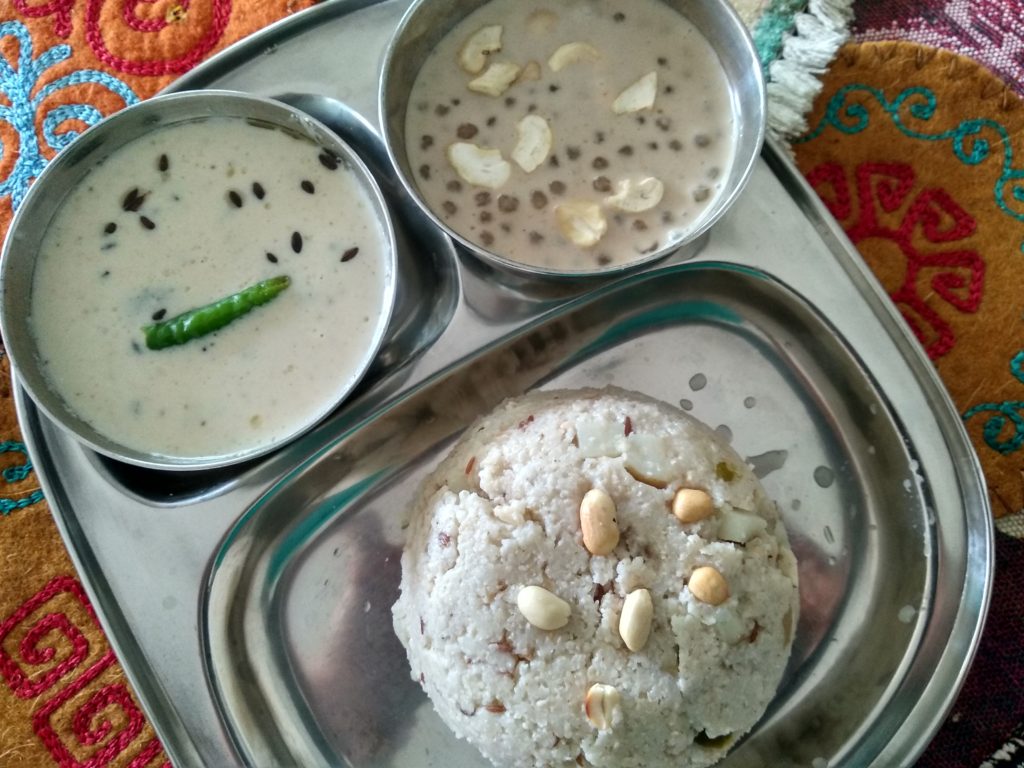
10 Oct Navratri recipes Day 2 / Thali for Day 2
Here is Thali for Navratri recipes day 2
Navratri is celebrated to worship the divine forms of Goddesses Durga (first 3 days), Lakshmi (next 3 days) and Saraswathi (last 3 days). These 9 days are supposed to be auspicious period for Hindus. In Maharashtra, Gujarat and some North Indian states, many people observe fast during the 9 days as offerings to these deities. Navratri fasting is very special with many do’s and dont’s. Keeping all these rules in mind, I have developed different recipes for different days of Navratri. These are fasting recipes that can make your fasting interesting.
This Thali for Day 2 has Sama Kichdi, Peanut Amti & Sabudhana Kheer

| Sama Kichdi | Peanut Amti | Sabudana Kheer |
|---|---|---|
| Ingredients: ½ cup sama ½ cup finely cut potatoes ¼ cup coarsely ground peanuts 1 tsp cumin seeds 1 green chilli finely chopped 1 tsp groundnut oil (you can use ghee) 1½ cups water Rock salt to taste Direction: 1. Wash and drain sama. 2. Heat oil / ghee in a pressure cooker, add cumin seeds. 3. Once the cumin splutters, add the green chillies, potatoes & sauté for few minutes. 4. Add sama, salt, peanut powder and sauté for few more minutes. 5. Add 1½ cup water. 6. Close the cooker and cook for 4 whistles. | Ingredients: 1/3 cup roasted peanuts 2 green chillies 1 tsp fresh coconut grated 1 tsp oil / ghee 1 tsp cumin seeds 1/3 cup curd (I used groundnut curd) 2 kokum flowers / 1 tsp tamarind paste / 2 tsp lime juice Rock salt to taste 2 cups water Direction: 1.Grind roasted peanuts, green chillies and grated coconut to a fine paste with 1/3 cup curd. Remove in a pan. 2. Add 1 cup water, Kokum flowers / tamarind paste, salt and boil on a low flame till the raw smell goes. If adding lime juice, add after you switch off the flame. 3. Heat oil and add cumin seeds. 4. Once the seeds splutter, add the tempering to the amti. 5. Adjust the consistency of the amti as per your need. | Ingredients: 1 tsp oil 1/3 cup sago (Sabudana) 4 tablespoon jaggery powder 1 tablespoon roasted cashew Pinch of cardamom powder ½ cup thin coconut milk (1/4 cup coconut milk+1/4 cup water) ½ cup coconut milk Direction: 1. Heat oil, roast sago. 2. Add ½ cup thin coconut milk and boil till the sago pearls become soft. Add more water if required. 3. Once the sago is cooked add jaggery powder and cook till the jaggery melts and mixes with sago. 4. Lower the flame, add coconut milk and bring it to just one boil. 5. Add roasted cashew and cardamom powder. |
The above food list is a generic one. You are at liberty to follow your family traditions.
Traditionally Vrat recipes use ghee or groundnut oil. By default ghee is avoided, being a dairy free site.
Tips:
- Do not starve yourself. Starving creates craving and we end up over eating. Dry fruits and nuts can be had in moderation to avoid starving.
- Consuming fresh fruits, fruit juices, coconut water, lime / kokum juice, etc helps in satiating the hunger and keeping the body hydrated.
- Most important thing to remember during these festivals is to keep our hearts pure. By observing fast we try to cleanse our body. It is equally important to cleanse our mind & hearts too. Removing negative thoughts and directing our energies towards positive & right actions, help cleanse the mind & hearts.




Sorry, the comment form is closed at this time.